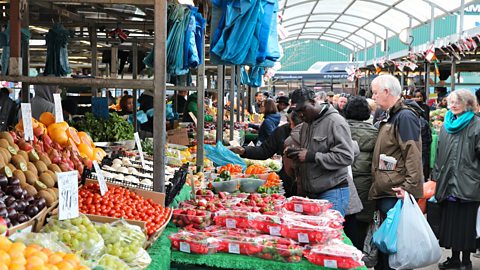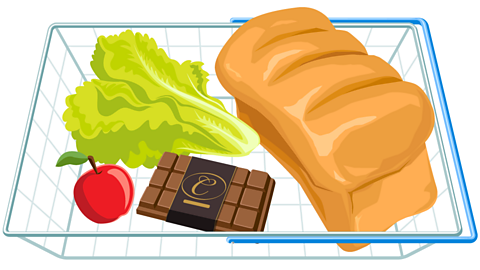Talking about food in Spanish.
When you’re talking about food in Spanish, it’s really useful to know how to say you do or don’t like something!
La pizza…me gusta la pizza.
‘I like’ is me gusta.
¿Te gusta la pizza?
No me gusta la carne porque soy vegetariano.
You put no in front of me gusta to say you don’t like something.
No me gusta la carne.
When you talk about liking more than one thing me gusta becomes me gustan.
Patatas fritas…me gustan las patatas fritas
¡No!
I hate rice!
¡Odio el arroz!
If you prefer something you use prefiero.
No me gusta el zumo de naranja…prefiero el zumo de manzana.
Mmmmmm, ¡Delicioso!
I love juice - me encanta el zumo.
My ideal meals would be:
For breakfast - el desayuno - cereales con leche.
For lunch - el almuerzo - la pasta.
For dinner, the evening meal - la cena - una pizza vegetariana.
Whatever you like, enjoy your meal!
¡Buen provecho!
Opinions on food
You can ask questions about what others like to eat and drink by using the verbs comer (to eat) and beber (to drink).
For example:
¿Qué te gusta comer? - What do you like to eat?
¿Qué te gusta beber? - What do you like to drink?
¿Qué no te gusta comer y beber? - What don’t you like to eat and drink?
You can respond to the question with your opinion, followed by the food or drink.
Remember to use the correct definite article (the word for ‘the’).
For example:
Me gusta el chocolate - I like chocolate.
No me gusta el pollo - I don’t like chicken.
Me encanta la pizza - I love pizza.

A verb is a ‘doing’ word or an action, for example ‘play’, ‘run’, ‘read’.
However, when you say me gusta or no me gusta followed by the infinitives comer or beber you don’t need to use the definite article.
For example:
- Me gusta comer galletas y beber leche I like to eat biscuits and I like to drink milk.

Can you use the language in the table below to talk about what you like to eat and drink?
| Spanish | English |
|---|---|
| la fruta | fruit |
| la pizza | pizza |
| las verduras | vegetables |
| el pollo | chicken |
| el arroz | rice |
| las tostadas | toast |
| el chocolate | chocolate |
| la manzana | apple |
| el plátano | banana |
| el pastel | cake |
| el pan | bread |
| la ensalada | salad |
| la pasta | pasta |
| el té | tea |
| el café | coffee |
Click on the downloadable vocabulary list to see more words for different foods and drinks.
Plurals of food
To say that you like a plural food or drink item you will need to add n to me gusta (I like).
For example:
Me gusta_n_ las verduras - I like vegetables.
No me gusta_n_ los huevos - I don’t like eggs.
To say why you like or dislike a single food or drink item, use porque (because) and es (is) followed by an adjective.

Adjectives are words used to describe people, places or things.
It is important to make sure that adjectives agree with the noun (a word for a person, place or thing ) that they are describing and are changed to the masculine or feminine form to match the noun.
For example:
Me gusta el chocolate porque es delicioso - I like chocolate because it is delicious.
Me encanta la fruta porque es sabrosa - I love fruit because it is tasty.
Me gusta la comida rápida porque es deliciosa pero no es sana - I like fast food because it is delicious but it is not healthy.
Can you use the table below to describe the different foods that you like or don’t like?
| Masculine | Feminine | Adjective in English |
|---|---|---|
| delicioso | deliciosa | delicious |
| asqueroso | asquerosa | disgusting |
| sabroso | sabrosa | tasty |
| salado | salada | salty |
| sano | sana | healthy |
| picante | picante | spicy |
El agua is a feminine noun, despite using the definite article el, so any adjectives used to describe it should also be feminine.
Giving a reason in the plural
To say why you like or dislike a plural food or drink item use porque (because) and son (are) followed by an adjective.
You will still need to make the adjective masculine or feminine, but also remember to make it plural, by adding an s onto it.
For example:
No me gustan los huevos porque son asqueroso_s_ - I don’t like eggs because they are disgusting.
Me encantan las patatas fritas porque son deliciosa_s_ - I love chips because they are delicious.
Talking about dietary requirements
It may be useful to talk about any dietary requirements that you may have. For example:
No me gusta la carne porque soy vegetariano/a - I don’t like meat because I am vegetarian.
No como huevos porque soy vegano/a - I don’t eat eggs because I am vegan.
No como nueces porque tengo alergia - I don’t eat nuts because I have an allergy.
Vegetarian_o_ and vegan_o_ are masculine adjectives, and vegetarian_a_ and vegan_a_ are feminine adjectives.
Saying what you eat for different meals
In Spanish, the verbs desayunar (to have breakfast), comer (to eat/have lunch), beber (to drink), merendar (to have an afternoon snack), cenar (to have dinner) and tomar (to have) can be used to describe what you eat or drink for each meal.
When you use these verbs you don’t need to use the definite article before the food or drink.

For example:
Por la mañana, desayuno tostadas - In the morning, I have toast for breakfast.
Para el almuerzo, como ensalada - For lunch, I eat salad.
Normalmente tomo arroz con pollo - Normally I have rice with chicken.
Todos los días meriendo fruta - Every day I have fruit for my afternoon snack.
A veces ceno pescado y ensalada - Sometimes I have fish and salad for dinner.
Para la cena, ¿bebes agua o zumo? - For dinner, do you drink water or juice?

Have a go at this activity to see how much you know about talking about food in Spanish.
Video
Watch the video and test your understanding of talking about food in Spanish in the short quiz!
PAULA: ¡El viaje con nuestras familias va a ser divertido! ¡Me encanta el camping!
ÁLVARO: A mi también. Pero tenemos que hacer la compra para el desayuno, el almuerzo y la cena.
PAULA: ¿Qué comes para el desayuno?
ÁLVARO: Para el desayuno como cereales con leche.
PAULA: No me gusta la leche. Desayuno huevos fritos y zumo de manzana.
ÁLVARO: A mi también me gusta el zumo, pero prefiero el zumo de naranja.
PAULA: Vale …¿Zumo y tostadas entonces?
ÁLVARO: Vale, muy bien. Me gustan las tostadas.
PAULA: ¿Y para el almuerzo?
ÁLVARO: Para el almuerzo normalmente como pasta o pollo.
PAULA: No como pollo porque soy vegetariana.
ÁLVARO: Ah, vale. Comemos pasta entonces. ¡Sin carne!
PAULA: Perfecto. ¿Qué te gusta comer para la cena?
ÁLVARO: Arroz…
PAULA: Odio el arroz. ¿Te gusta la pizza?
ÁLVARO: ¡Me encanta la pizza! Con mucho queso.
PAULA: Vale, pizza con mucho queso entonces.
ÁLVARO: ¿Puedes comer queso?
PAULA: ¡Claro! ¡Soy vegetariana, no vegana!
ÁLVARO: Ok…una cosa muy importante…¡postre!
PAULA: A mí me gusta mucho la fruta…o el helado de chocolate.
ÁLVARO: Mmmmm….helado de chocolate. ¡Qué delicioso!
PAULA: Perfecto, ¡ya tenemos todo entonces!
Translation:
PAULA: The trip with our families is going to be fun. I love camping!
ÁLVARO: Me too. But we have to do the shopping for breakfast, lunch and dinner.
PAULA: What do you eat for breakfast?
ÁLVARO: For breakfast I eat cereal with milk.
PAULA: I don’t like milk. For breakfast I have fried eggs and apple juice.
ÁLVARO: I like juice too, but I prefer orange juice.
PAULA: OK…Juice and toast then?
ÁLVARO: OK. Great. I like toast.
PAULA: And for lunch?
ÁLVARO: For lunch I normally eat pasta or chicken.
PAULA: I don’t eat chicken because I’m vegetarian.
ÁLVARO: Ah OK. We’ll eat pasta then. Without meat!
PAULA: Perfect. What do you like to eat for dinner?
ÁLVARO: Rice…
PAULA: I hate rice. Do you like pizza?
ÁLVARO: I love pizza! With lots of cheese.
PAULA: OK, pizza with lots of cheese then.
ÁLVARO: Can you eat cheese?
PAULA: Of course! I am vegetarian, not vegan!
ÁLVARO: OK, something very important…dessert!
PAULA: I really like fruit…or chocolate ice cream.
ÁLVARO: Mmmmm…chocolate ice cream. Delicious!
PAULA: Perfect, we have everything then!
Quiz
GCSE exam dates 2025
Find out everything you need to know about the 2025 GCSE exams including dates, timetables and changes to exams to get your revision in shape.

More on Topics
Find out more by working through a topic
- count4 of 9

